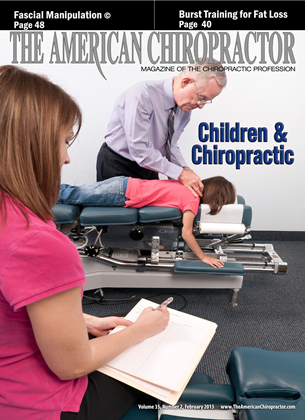History and Presenting Symptoms This female patient is a 51-year-old small business owner and exercise enthusiast. She reports pain in the front of her left knee over the past several months, especially when exercising at the gym. She has no obvious swelling or discoloration and denies any specific injury. She reports that she takes over-the-counter medication for relief, but is worried about taking dnigs in order to complete her exercise regimen. Exam Findings Vitals. This active, middle-aged woman weighs 138 lbs. which at 5"4" results in a BMI of 23.7 - not overweight, but at the higher end of normal. She is a non-smoker, and her blood pressure and pulse rate arc both at the lower end of the normal range. Posture and gait. Standing postural evaluation finds generally good alignment throughout her pelvis and spine. She has a mild bilateral knee valgus and moderate calcancal eversion and hypcrpronation on the left side. Measurement finds a standing Q-anglc of 27° on the left and 23° on the right (20° is normal for women). Chiropractic evaluation. Motion palpation identifies a limitation in lumbosacral motion, with moderate tenderness and loss of endrangc mobility to the left at L5/S1. A compensator} fixation is also noted at T10/T11. Neurologic testing is negative. Primary complaint. Examination of the left knee indicates no ligament instability, but there is a positive patellar grinding test. All knee ranges of motion arc full and pain free, bilaterally. Manual muscle testing finds no evidence of muscle weakness. Imaging No x-rays or other forms of musculoskclctal imaging were requested. Clinical Impression Patello-fcmoral arthralgia on the left, associated with an elevated Q-anglc and foot pronation. This is accompanied by lumbosacral joint motion restriction and compensatory lower thoracic fixation. Treatment Plan Adjustments. Specific, corrective adjustments for the lumbosacral joint and the lower thoracic region were provided as needed. Manipulation of the left knee into external rotation was performed to decrease the internal rotation associated with hypcrpronation and her elevated Q-anglc. Support. Individually designed stabilizing orthotics were provided to support her arches and decrease her Q-anglcs. Two pairs of stabilizing orthotics were ordered - one designed specifically for her gym shoes and the other for her job-related dress shoes. Rehabilitation. Due to her active lifestyle, no specific rehabilitation exercises were provided. She continued with her frequent activities at the local gym. Response to Care The adjustments for the spine and knee were well-tolerated, and she reported what appeared to her to be a rapid decrease in symptoms. After this patient began wearing her orthotics regularly, she indicated noticing a substantial decrease in knee irritation with use. and a firmer foot plant during aerobics. Within three weeks of receiving her orthotics. she related that she was performing all of her favorite workout routines with no knee pain or limitation. She was released to a serf-directed stretching program after a total of eight treatment sessions over two months. Discussion Several factors in this case make it quite interesting. This high-powered business woman used her gym time as both a form of recreational relaxation and a place for business networking. As her knee began to bother her more, she was driven to begin using anti-inflammatory dnigs. She did start wearing more supportive footwear, but her underlying bio mechanical problem had not been sufficiently addressed. When women are physically active, their naturally higher Q-anglcs are frequently a source of lower extremity pain. Patcllo-fcmoral arthralgia (previously known as chondromalacia patellae) has been recognized as a biomcchanical tracking disorder of the kneecap in the femoral groove. The best treatment is a conservative approach, with a combination of chiropractic adjustments, stabilizing orthotic support, and - when indicated - rehabilitative strengthening sessions using exercise tubing. Dr. John J. Danchik. the seventh inductee to the AC A Sports Hall of Fame, is a clinical professor at Tufts University MedicalSchooland'formerly chaired the U.S. Olympic C 'ommillee s CliiropracticSelection Program. Dr. Danchik lectures on current trends in sports chiropractic and rehabilitation. He can be reached at docforjocs'S.aol.coni or 617-489-1220.
 View Full Issue
View Full Issue






